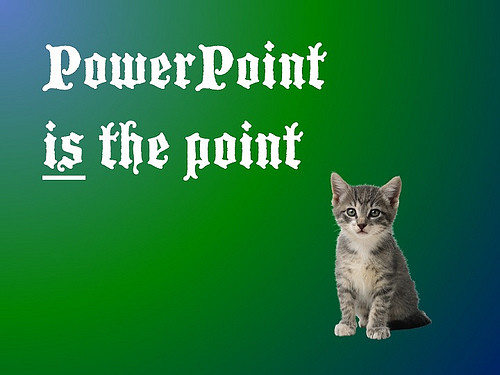If you work for the government there's a lot that's interesting about this talk. Though, typically, I've probably got the wrong end of the stick because the line that really stuck with me was:
"When you adopt a tool you also adopt the management philosophy embedded in that tool"
And what I instantly thought about was Powerpoint.
(When I say Powerpoint, I mean Generic Presentation Software. Right now, at work, I use PowerPoint, Keynote and Google Docs, they all have good points and bad points, it's just easier to call them Powerpoint.)
Arriving at GDS made me realise how much of my professional life has been spent in Powerpoint. It's my default tool for writing and thinking, most of the organisations I've been in are the same.
That's less true of the Civil Service though, where the default tool seems to be Word, or something similar - something, anyway, for making documents. This is possibly as it should be, documents are about detail and detail is important when you're running a country and drafting laws.
I wouldn't want statutes written in 36-point Times New Roman on a graduated blue background. But, it might also be worth examining the merits of Powerpoint, because - when done well - Powerpoint can be a great tool for making 'Agile Strategy'.
The assumption embedded in Powerpoint is - it's going to be talked about, because it's going to be presented, and a presentation has people in the room. Powerpoint causes conversation. Wheras Word is there to be read. It's private, in your head. Word is private, Powerpoint is social.
Word encourages addition. The way people work on documents is to add things to them, make them longer. But Powerpoint tends to limit that - it's normally measured in time ("you have 20 minutes") - so it makes you prioritise and decide what you really want to say.
If Word is about detail, then Powerpoint is about essence. The main points, the key things, the story.
Powerpoint is quick, you can get to that essence in minutes or hours. You can present, revise, represent, get approval and move on at speed.
And Powerpoint is visual. It can be printed out and stuck on the walls - like the stickynotes and whiteboards of Agile. It's instantly and easily shareable.
(That reminds me, I need to write more about walls.)
You get the idea.
Now there are probably other, less useful, management assumptions baked into Powerpoint - stuff to do with power relations for instance - and it could certainly be approved, but those of us who've learned to be good at Powerpoint are very lucky. It's a good tool for a fast, flexible, agile world. It's going to be handy.
(And for everyone who think of this kind of thing when they think about Powerpoint, or this, THAT'S NOT WHAT I MEAN. I mean Powerpoint done well. Which, these days, it often is. MOVE ON.)
